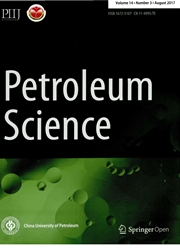

 中文摘要:
中文摘要:
反应表面区域,控制矿物质反应的一个重要参数,影响矿化作用套住影响长期的 CO2 存储的 CO2 的数量。CO2 套住的矿化作用上的反应表面区域的效果数字地在盐的含水土层为 CO2 存储被模仿。包括钙长石,方解石和 kaolinite,三种矿物质涉及矿物质反应。这份报纸从文学基于试验性的数据为在特定的表面区域和钙长石的谷物直径之间的关系建模(Brantley 和 Mellott, 2000 ) 。当钙长石和方解石的反应表面区域从 838 ~ 83.8 m2/m3 减少时,矿化作用在 500 年以后套住 CO2 的百分比从 11.8% ~ 0.65% 减少。当钙长石和方解石的反应表面区域从 838 ~ 83.8 m2/m3 减少时,溶解钙长石的数量和猛抛的 kaolinite 和方解石的数量显著地减少。方解石开始在盐水被溶解然后在在 CO2-H2O 和矿物质之间的 geochemical 反应期间猛抛。钙长石和方解石的不同反应表面区域从溶解导致不同时间到降水。盐水的 pH 与影响盐的含水土层的酸味的钙长石和方解石的减少的反应表面区域减少。在盐的含水土层的上面、更低的部分之间的煤气的浸透与钙长石和方解石的减少的反应表面区域增加。CO2+brine 答案区域与钙长石和方解石的减少的反应表面区域增加的盐水答案表演的集体密度分发。
 英文摘要:
英文摘要:
The reactive surface area, an important parameter controlling mineral reactions, affects the amount of mineralization trapping of CO2 which affects the long-term CO2 storage. The effect of the reactive surface area on the mineralization trapping of CO2 was numerically simulated for CO2 storage in saline aquifers. Three kinds of minerals, including anorthite, calcite and kaolinite, are involved in the mineral reactions. This paper models the relationship between the specific surface area and the grain diameter of anorthite based on experimental data from literature (Brantley and Mellott, 2000). When the reactive surface areas of anorthite and calcite decrease from 838 to 83.8 m^2/m^3, the percentage of mineralization trapping of CO: after 500 years decreases from 11.8% to 0.65%. The amount of dissolved anorthite and the amounts of precipitated kaolinite and calcite decrease significantly when the reactive surface areas ofanorthite and calcite decrease from 838 to 83.8 m2/m3. Calcite is initially dissolved in the brine and then precipitates during the geochemical reactions between CO2-H20 and the minerals. Different reactive surface areas of anorthite and calcite lead to different times from dissolution to precipitation. The pH of the brine decreases with decreasing reactive surface areas of anorthite and calcite which influences the acidity of the saline aquifer. The gas saturation between the upper and lower parts of the saline aquifer increases with decreasing reactive surface areas of anorthite and calcite. The mass density distribution of brine solution shows that the CO2^+brine solution region increases with decreasing reactive surface areas ofanorthite and calcite.
 同期刊论文项目
同期刊论文项目
 同项目期刊论文
同项目期刊论文
 Experimental Investigations of the Fissure Effect on Supercritical Pressure CO2 and Water Flow in Si
Experimental Investigations of the Fissure Effect on Supercritical Pressure CO2 and Water Flow in Si 期刊信息
期刊信息
